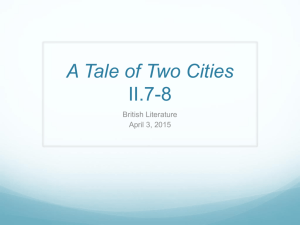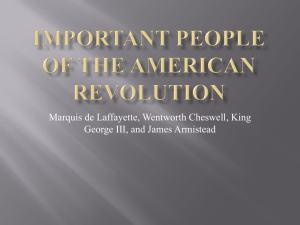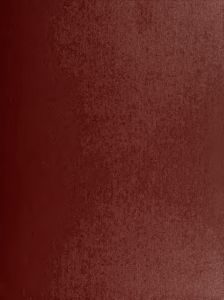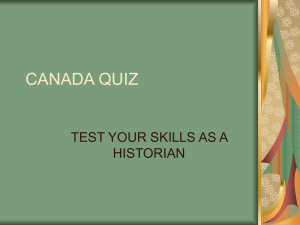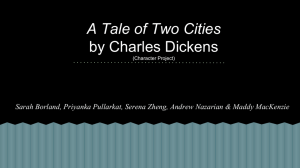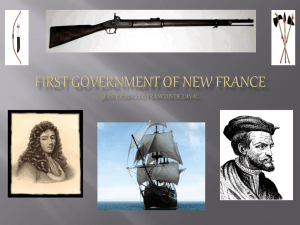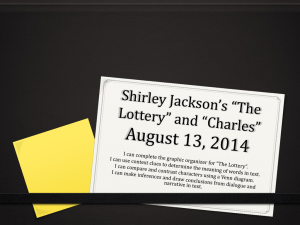Insights into A Tale of Two Cities
advertisement
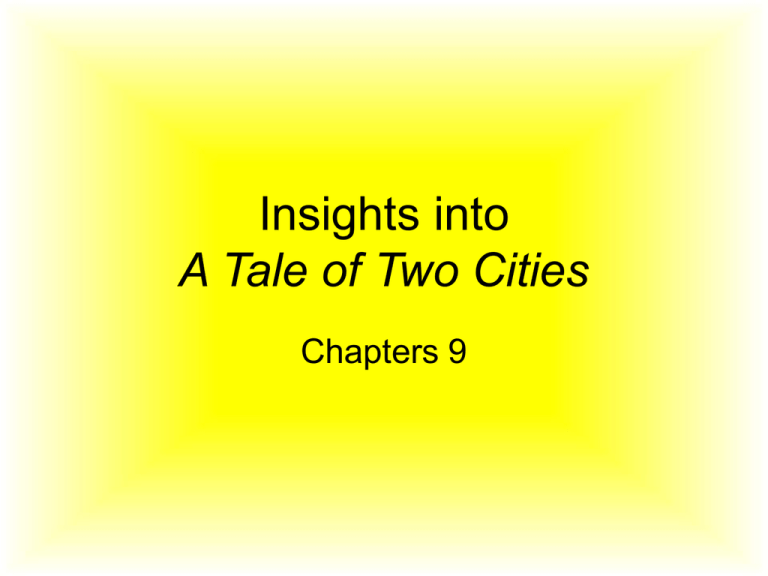
Insights into A Tale of Two Cities Chapters 9 CHAPTER 9: “The Gorgon’s Head” The title of Chapter 9 is an allusion to Homer’s epic poem “The Odyssey”--which you studied your freshman year in English I. Remember that a Gorgon is from Ancient Greek mythology. It was a vicious female with fangs and the skin of a serpent. There were three Gorgons, one of which was Medusa, the only mortal Gorgon, who had snake hair as a punishment from Athena. If you looked into the Gorgon’s eyes, you were turned to stone Chapter 9 takes place at the chateau of the Marquis. A château is a manor house or residence of the lord of the manor or a country house of nobility or gentry, with or without fortifications. Keep in mind that the Marquis is already on edge because of what the mender of roads has told him he has seen in relation to his carriage (see p. 116). On pages 120 and 121, the Marquis thinks he is seeing things outside the blinds of the window. (This is important foreshadowing. We learn on page 119 that “Monsieur Charles” is the Marquis’ nephew. Since we only know one Charles in our story, we may accurately assume that this nephew of the Marquis is the same Charles we saw cross the English Channel with Lucie and her father—and the one who is obviously falling in love with Lucie. It’s important that you pay attention to the strained relationship between Charles and his uncle (illustrated on pages 121-128. MAKE SURE YOU UNDERSTAND THE PHILOSOPHICAL DIFFERENCES THAT CHARLES AND THE MARQUIS HAVE CONCERNING THE ARISTOCRACY AND ITS POWER IN FRANCE. Be sure to mark and define the term “letter de cachet” at the top of page 123. Your comprehension of the rest of the novel requires that you understand what this is. (See next slide.) In French history, lettres de cachet were letters signed by the king of France, countersigned by one of his ministers, and closed with the royal seal, or cachet. They contained orders directly from the king, often to enforce arbitrary actions and judgments that could not be appealed. The best-known lettres de cachet were punishment, by which a person was sentenced without trial and without an opportunity of defense to imprisonment in a state. The wealthy sometimes bought such lettres to dispose of unwanted individuals. In the middle of the page on 124, be sure to note the very obvious foreshadowing the narrator gives about what’s to happen to the Marquis’ and other aristocrats’ chateaus: “If a picture of the chateau as it was to be a very few years hence, could have been shown to him that night, he might have been at a loss to claim his own from the ghastly, fire-charred, plunderwrecked ruins.” On page 125, you have a VERY important piece of information given about Charles: “Can I separate my father’s twin-brother, joint inheritor, and next successor, from himself?” In other words, Charles has told us (through indirect characterization) that the Marquis is his father’s twin brother. Because of the Marquis’ response (“Death has done that!”), we can infer that Charles’ father is dead, and his twin brother—Charles’ uncle—is now the Marquis (which is the title). So we know that, if Charles’ uncle were to die, Charles would be the next Marquis. Also on page 125, be sure to mark Charles’ feelings about the property and power he will inherit from his uncle (the Marquis) once his uncle dies: “This property and France are lost to me…I renounce them.” Don’t miss the fact that the uncle (the Marquis) implies on pages 126-127 that he is familiar with Dr. Manette and Lucie, who are in England. At the bottom of page 127 (2nd to the last paragraph), the narrator provides us with the animal imagery of Monsieur the Marquis as a tiger. Pages 129 and 130 are EXTREMELY important. By the end of the chapter (see the last two paragraphs), something significant has happened to Monsieur the Marquis. Dickens gives us three clues to the person who is responsible for this occurrence: 1. the verb “scrawled” (which you have seen before) 2. the fact that the note says to drive the Marquis “FAST” to his tomb 3. the signature “Jacques”
